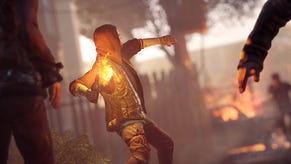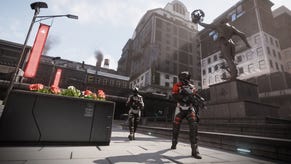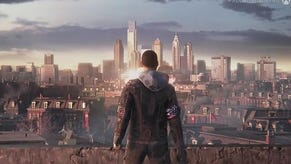Interview - Homefront's lead designer discusses why the US is sensitive to the game's themes
After playing the first 15 minutes of Homefront, VG247 got in touch with lead level designer Rex Dickson from Kaos Studios to talk about the game’s unsettling portrayal of a Korean invasion of the United States, and why American audiences seem especially affronted by it. Apparently, you guys need to adjust your cultural mentality – can Homefront do it for you?
Hopefully, because as Dickson puts it, the US has never had to deal with the possibility of an invasion like other countries and has the "elitist idea" it's the "best the world". Because of this bravado, Kaos Studios preys upon the idea of excess, democracy and freedom being stripped away, and how the US portrayed in game is unprepared to deal with an invasion by a formidable opposing force.
VG247: There’s a lot of brutality on show in Homefront’s opening section. How does Homefront use violence in its narrative?
What we’re going for is not necessarily violence in a gore kind of way, but more an emotionally unsettling context. One of our big goals is to make players feel… All first-person shooters are obviously violent, but what if we had violence with real consequences and human emotion? That’s what we’re going for. Having a lot of gore wasn’t the goal; it’s all about these emotionally charged situations.
What’s the justification for the brutality of this invasion that you’re depicting?
Any occupying army in a foreign country is going to have these elements of brutality, mainly because – and this is a big theme in Homefront – war brings out the worst in people. And this doesn’t only apply to the Korean army Over the course of the game you’ll find that there are segments of the American population that are actually behaving just as brutally. One of the big themes across the entire game is that we don’t demonise the Koreans – it’s just the theme that war brings out the worst in humanity.
The structure and viewpoint seems to owe a lot to Half-Life 2. Would you say that was an inspiration?
Absolutely. Half-Life 2 was our biggest inspiration. Kaos Studios’ pedigree wasn’t in big narrative single-player campaigns – our territory has always been multiplayer. So when we decided that we wanted to make this kind of game, we looked at the past ten or twenty years of gaming and though, who’s done it the best? And we felt that nobody has done it better than Valve with Half-Life 2, so we used that as our model.
A few of the themes that you’ll find carry over from HL2 into our game is the idea of an oppressed population, and also the main character not having a voice. I think the biggest one is never cutting the camera away from the player, or rarely doing that.
The modern FPS tends to rely heavily on setpieces for storytelling - is continuity important to you?
Yeah absolutely, and not only that but I think generally people don’t want to watch movies when they buy a game. You can make a good argument for games like Final Fantasy that use cutscenes to great effect, but I find that usually when a movie starts playing, people want to skip it, they start hitting the button. If they’re not willing to watch the scene, then we shouldn’t be investing our time and energy into it. So we really wanted to keep the player in the game the whole time and always give them a reaction when they do something with the controller, rather than blocking them out from it.
Homefront certainly has a different feel from the mainstream military FPS – is this intentional?
Yes. If you look at the landscape now, it feels a lot to me like everybody is going after COD’s market share or Halo’s market share. But for us, as gamers, instead of doing that, what we want to do is give the public something new, something different. With all these clone projects coming out, we think the market is actually desperate for someone to inject a new bit of creativity into the FPS formula, and bring something new to the market.
Do you feel the suburban American setting is a big part of that?
If you look at other products, you see a lot of people do these iconic locations – the White House, New York City, places that are familiar to everybody, landmarks that you can easily find. But what we wanted to do was create environments that were familiar to a large amount of people. We wanted it to feel like people’s hometown. Whether you’re from Ohio or Kentucky or wherever it is you’re from, these towns look like your town, and that presents an element of “That looks like my backyard, that looks like the school I went to.” It creates this unsettling environment, whereas a more iconic landmark like the Statue of Liberty would have a completely different context.
A lot of people are apparently affronted by the “implausibility” of a Korean invasion of North America. Why do you think people are so sensitive about that?
That’s a good question. Honestly I think people part of the reason that people question the plausibility is because we’re using this real-world footage in our trailers, which is unique to us, and it immediately makes people ask questions like “How realistic is this?” If you do your research you’ll learn that North Korea has the fourth largest standing army in the world, and as time goes on you see the American financial crisis and military forces stressing the Middle East - this really isn’t that far-fetched a concept. There are border engagements between North and South Korea once every few months or so.
I think that people are grasping onto is this idea that America could never be invaded, that we’re untouchable, and that’s kind of what we’re going after, to build on that fear, that paranoia, that feeling of “God, how could this ever happen here?” And some people are so unwilling to accept that possibility that they just dismiss the concept outright as implausible.
Do you think it would be the same if it were set somewhere in Europe, for instance?
If you think about it, places like Europe and the Middle East over the years have had these situations where there’s been war on their home turf, where there’s been the threat or the fact of invasion, and that’s not something that the US has ever had to come close to dealing with. But that’s one of the things that the game deals with. Probably more than any other society, America has this elitist idea that we’re the best in the world and also this culture of excess, and we prey upon the idea in the game. When all these things get stripped away – the life of convenience, democracy – perhaps more than any other culture, Americans are the least equipped to deal with that situation.
Homefront is out March 8 in the US and March 11 in Europe and the UK.













_ddwYK80.png?width=291&height=164&fit=crop&quality=80&format=jpg&auto=webp)


